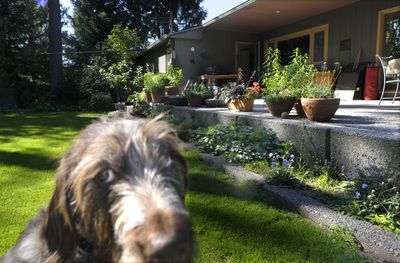Just add nature
Washington state’s Master Gardener Program can show you the way to a more natural landscape

Like most homeowners, Tonie Fitzgerald’s South Hill home came with a standard backyard consisting of a sweeping lush lawn.
“There were no birds or anything here. It was just a sterile environment,” she said.
A former county extension agent who now leads the state’s Master Gardener program, Fitzgerald has gradually ripped out about half the grass – substituting wildflowers, shrubs and trees native to Eastern Washington’s Ponderosa pine ecosystem.
“When we take ‘nature’ out of the landscape, the wildlife has nowhere to go and then they become what we think of as pests,” she lamented. “People don’t realize what development does to (eradicate) wildlife habitat.”
Today, her back lawn is about half the size it was originally. It’s bordered by thicket of tall pines, three kinds of maples, Oregon grape, ash trees, springs of snowy ocean spray, snowberry bushes and birch leaf spiriea – crisscrossed by walking paths.
“In the summer, it just buzzes,” with dragonflies, chickadees, butterflies, bees, juncos, hummingbirds, finches, woodpeckers and squirrels.
In addition to adding a wildlife oasis, she’s created a backyard that’s drought tolerant, low maintenance and requires far less water during the growing season.
If you’d like to learn the secrets of transforming your property like Fitzgerald did, you’ll want to attend a series of four “Specialty Landscaping Classes” – offered by the Washington State University Master Gardeners program. The first session is Saturday.
When offered last spring, the courses filled up immediately and about 50 folks had to be turned away, said Penny Simonson, program coordinator.
She’s thrilled to find residents becoming more attuned to natural landscaping techniques. Such methods not only reintroduce displaced plant and animal species, they help create drought-tolerant and low-maintenance yards, she said.
“We have some really good suggestions to help them save water, time and money while caring for a landscape that is pleasing to the eye,” she said.
When naturalized, yards “attract birds, bees, butterflies and other wildlife that appreciate the sanctity and safety of a yard free of pesticides and other chemicals. Native plants want to grow here in our area. They were here before we were,” she added.
Don’t worry if your idea of a perfect landscape includes grass.
“We completely understand the homeowner’s love for their lawn and we do not say get rid of your lawn, we wouldn’t dare,” Simonson stressed. “We suggest instead they identify how much lawn they really need and then we’ll show them how best to care for it.”
Here’s Simonson’s rundown on the classes, all from 10 a.m. to noon at WSU’s Spokane County Extension Office, 222 N. Havana St.
•Saturday, “Seven Steps to Water Wise Watering,” by WSU Master Gardeners. “We walk the homeowner and commercial land owners through understanding their site conditions, soil type and preparation, grouping plants with like watering needs, putting the right plant in the right place, mulching for water retention and developing a practical turfgrass area.”
•Sept. 27, “Xeriscaping,” by WSU Associate Scientist Steven Link. “Xeric, by definition, means landscaping with low watering needs. It is not ‘zero-scaping,’ it is landscaping with plants that don’t require a lot of moisture and incorporating the use of hardscapes…rather than plant material.”
• Oct. 4, “Landscaping with Native Plants,” by WSU Master Gardener Eva Lusk. Her “yard and garden are a backyard wildlife refuge, filled…with native and drought tolerant plants. When a yard is naturalized like that, it attracts birds, bees, butterflies and otherwilfe that grow in our area and were here before we were.”
• Oct. 11, “Rain Gardens,” by WSU Agriculture Coordinator Carol Mack. Learn to “create a landscape of plant material that can be watered by harnessing rainfall. If your landscape lends itself to a layout with the right amount of grade, you can incorporate plants that might want a little more water – and the water will be naturally.”